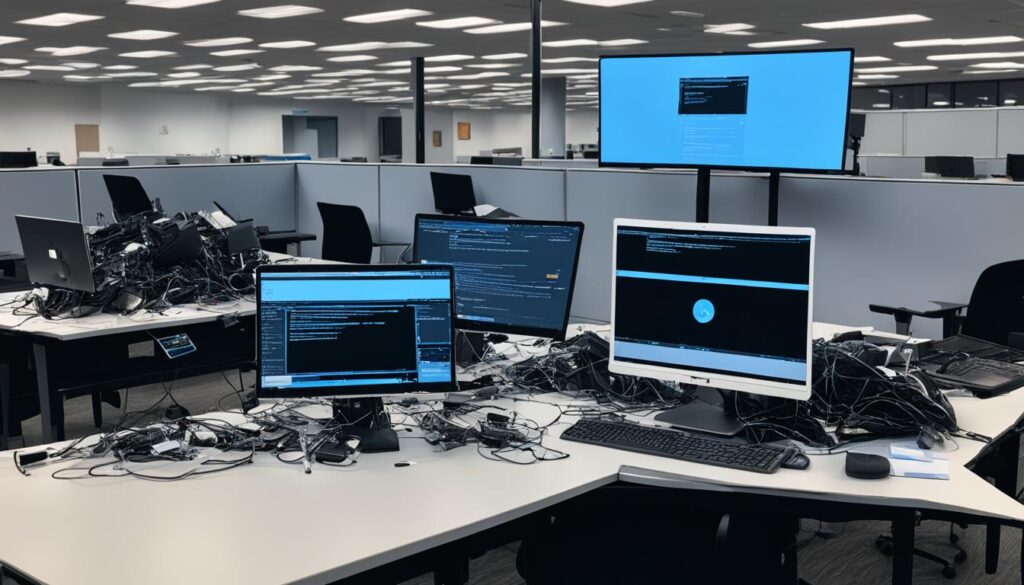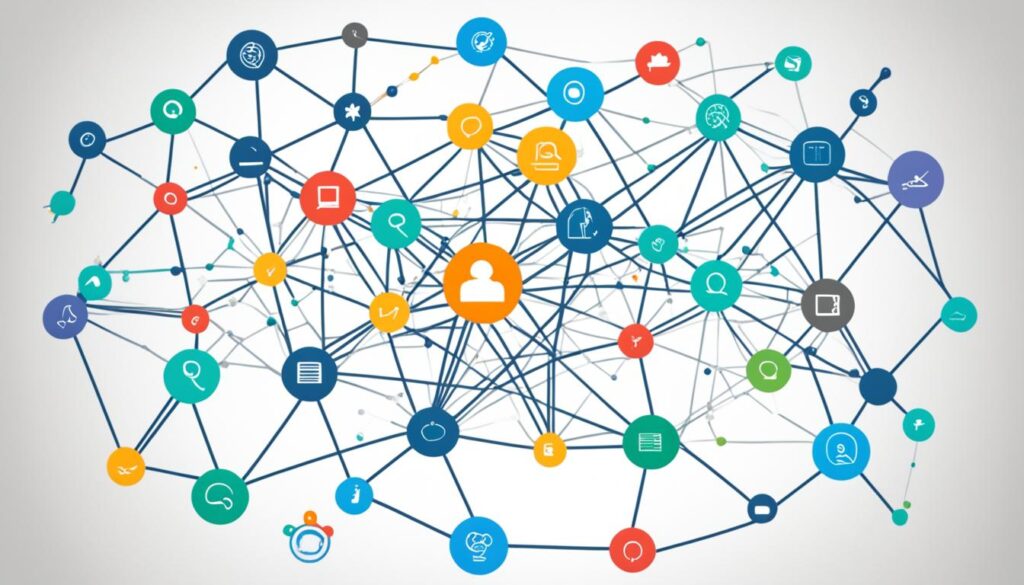Picture this: you’re right in the middle of a key business task. Or you’re digging into deep research. You’re counting on ChatGPT for vital information. Suddenly, the service goes down1. All work stops abruptly. This happened to many on June 4, 2024.
For over four hours, the outage hit everyone using ChatGPT across all plans. It was a clear sign of our deep reliance on AI. This dependency shapes how we live and work every day1.
The trouble started at 2:15 pm GMT and lasted until 5:01 pm GMT the next day. It was the first big issue in a while for ChatGPT1. Besides causing service interruptions, it triggered responses from the tech world and banks. OpenAI and Google DeepMind staff, in a joint letter, highlighted AI risk and called for more oversight1.
What made this even more serious was Treasury Secretary Janet Yellen’s warning. She spoke at the 2024 Conference of the Financial Stability Oversight Council. Yellen stressed the need for strong AI risk management. She cautioned about the dangers of complex and hidden AI models. These comments point to the importance of sticking to ethical standards in an industry that’s set to receive nearly $200 billion by 20252.
Reflecting on ChatGPT’s June 2024 issue, it’s clear that we need better measures for technology reliability. AI’s role, its upcoming innovations, and future trends are crucial. They will shape the next AI era1.
Key Takeaways
- The ChatGPT outage on June 4, 2024, lasted over four hours, affecting all users on all plans1.
- This interruption marked the first significant downtime for ChatGPT in a considerable period1.
- Employees from OpenAI and Google DeepMind signed a letter addressing AI product risks1.
- Treasury Secretary Janet Yellen highlighted the importance of AI risk management frameworks1.
- AI investments are projected to approach $200 billion by 2025, underscoring its rapid growth2.
Overview of ChatGPT’s June 2024 Outage
On June 4th, 2024, ChatGPT had a big problem. It started at 2:15 pm GMT and lasted over four hours. Everyone using ChatGPT faced this issue, no matter their plan. It was the first time in a while that ChatGPT had such a big problem. This showed just how much we rely on AI for work and daily life13.
Timeline of Events
The trouble began at 2:15 pm GMT on June 4th. It caused a lot of stops and starts for the 13 million people using it every day. Despite quick efforts to fix it, the service went down again, adding to people’s frustration3. The problem lasted over four hours, finally getting fixed the next day1. OpenAI quickly gave advice to those trying to use ChatGPT on computers and phones.
Extent of Impact
In June 2024, 79% of ChatGPT users found everything was messed up. Another 15% had problems with specific apps, and 6% couldn’t even get on the website3. OpenAI saw how widespread this was. It made many people from top AI companies join together and raise concerns about AI technology’s risks and ethics1.
Technical Causes Behind the Outage
In June 2024, ChatGPT faced a significant outage. It affected users all over the world. The main reasons were server overload, maintenance, and system failures. These issues showed that AI can struggle to keep up during busy times.
Server Overload Issues
On June 4, 2024, ChatGPT’s servers couldn’t handle the sudden high demand. This led to a major service outage. Such situations reveal a need for AI systems to have better capacity and resilience. This way, they can deal with high loads without major troubles4.
The advancement of AI technology means such outages are more worrying. They can cause big financial losses. For example, when services go down, companies might lose up to $1 million for each hour2.
Maintenance and System Failures
Server overload wasn’t the only problem. Issues related to maintenance and system failures made the outage worse. This is a reminder of how crucial solid infrastructure and regular check-ups are for AI’s dependability4.
OpenAI is committed to reducing such troubles. They use Internet Performance Monitoring (IPM) and predictive analytics. These tools help spot problems early, preventing bigger issues for users2.
User Reactions to the ChatGPT June 2024 Outage
People were very upset when the ChatGPT AI went down in June 2024. This caused a lot of problems globally4. Out of the 13 million users, 79% had issues. 15% had app problems, and 6% couldn’t even visit the website3. It shows how much people rely on ChatGPT for their work.
Frustration and Disappointment
Many users spoke out about how frustrated and disappointed they were because of the outage4. It lasted about eight hours and caused trouble for many tasks, from research to customer service5.
Impact on Workflows and Interactions
The outage changed how people worked and communicated daily. ChatGPT is essential for many, and not having it was a big setback4. It showed the importance of strong AI and the need for better system resiliency4.
| User Statistics | Impact |
|---|---|
| Daily users affected | Approximately 13 million3 |
| General issues | 79% of users3 |
| App-related issues | 15% of users3 |
| Website access issues | 6% of users3 |
| Duration of outage | Nearly eight hours5 |
Financial Impact of Increased AI Downtime
AI downtime, as seen with the recent ChatGPT outage, hits businesses hard. Many companies face big financial losses when AI services stop working. This trend follows the booming growth of AI technology. However, the risks grow with it.
When AI services are down, businesses can see their costs rise fast. Some even lose up to $1 million every hour. This shows just how much companies rely on AI tech these days.
Cost to Businesses
When AI systems go offline, it directly hits businesses in the pocket. Costs pile up from operations grinding to a halt, projects getting delayed, and communication breakdowns. For example, OpenAI’s ChatGPT boosts productivity for many tasks.
But, any pause in its service can lead to a surge in expenses. Research shows that firms using AI well can cut downtime costs by up to 40%. This is because they can make their hardware more efficient with AI’s help6.
Service Interruption Expenses
AI downtime affects operations in many ways. It can lead to losses in crucial activities like market analysis, creating content, and engaging with customers. When AI goes down, these key activities suffer immediately.
Still, tools like ChatGPT help firms save a lot each year, more than $75,000 for some. This shows how important AI tools are for everyday work. But their true value becomes clear when they’re not working. Then, companies feel the financial pinch right away, underlining the need to reduce AI downtime7.
Lessons Learned from the Outage
The recent outage highlighted the need for strong infrastructure and careful monitoring in AI’s fast-changing world. This sudden stop in service showed weak points that need fixing to keep the business going. Keeping a hardy infrastructure is crucial for dependable AI growth.
Importance of Robust Infrastructure
The outage taught us how vital strong infrastructure is. It showed us without proper backup, service disruptions can affect everyone for hours before fixing1. It’s a wake-up call for companies to use IT solutions that ensure they are always available. With a solid foundation, businesses can handle heavy loads and failures, making AI more dependable.
Need for Proactive Monitoring
Proactive monitoring is just as critical. Continuous checks mean any problems can be caught early, keeping downtime short and saving money1. This method also deals with complicated issues and poor risk management in AI systems1. Setting up watchful eyes in your IT plan helps you catch and fix problems fast, helping business and avoiding harm to your reputation.
Overall, the outage taught us how key it is to have a strong backbone and keep a close eye on your systems to support AI and business growth without interruptions.
OpenAI’s Response to the June 2024 Outage
In June 2024, OpenAI faced an outage with ChatGPT, affecting many users. They quickly jumped into action to fix the problems. OpenAI openly talked about the incident, calling it an “unresolved incident.”89 They promised to work fast to make sure it doesn’t happen again, showing their care for users like you.
OpenAI made sure to tell its users they are working hard to make ChatGPT better and more reliable. They know how important ChatGPT is, with over 100 million people using it worldwide. By keeping everyone informed, they tried their best to make users feel supported8.
OpenAI didn’t just focus on fixing the tech issue. They also aimed to be utterly honest by sharing updates regularly. This action shows how much they understand we rely on AI for so much. And we need it to work well, whether for fun or work, so good service and support are vital9.
Also, OpenAI took steps to make ChatGPT’s system stronger after the outage. They are dedicated to making sure it’s more reliable, winning back users’ trust. This focus on better AI tech and support highlights OpenAI’s leading role in the field8.
Implications for AI Technology Trends
The recent ChatGPT outage showed big AI risks. It highlighted worries about AI being dependable. Companies need to make their systems stronger and watch them carefully. This is to make sure AI tools can be trusted as they get better.
Vulnerabilities in AI Systems
In a 2023 IBM survey, 42 percent of big companies said they use AI10. But, adding AI can bring troubles that mess up many jobs. Even though 38 percent are using generative AI, they still find it hard to rely on10. As AI gets bigger, 44 percent of people worry their jobs might change by 2028 because of AI10. This shows the need to train and teach people new skills. It will keep everything running smoothly.
Reliability and Stability Concerns
Making sure AI works well and is trustworthy is key. But, the work to build and keep AI up could raise the pollution by 80 percent10. So, there’s a big push to make AI that doesn’t harm the environment. OpenAI’s GPT has more than a trillion settings11. This shows how much we need to keep making AI better. We want AI that’s strong, steady, and good for everyone to use.
Future Innovations in AI Technology
In the future, AI technology will get better at predictive analytics and real-time monitoring. Companies are working hard to use AI in every part of their operations. So, improving in these areas is important. It helps companies find problems ahead of time and fixes them before they cause big issues.
Advancements in Predictive Analytics
Predictive analytics is a big deal in AI’s growth. Between 2023 and 2028, AI will change 44 percent of the work people do. This shows how crucial AI is in predicting trends and getting ready for what’s ahead10. Many businesses all over the world are investing in predictive analytics. They want systems that can see future challenges and adapt without much trouble.
Improvement in Real-time Monitoring
Making real-time monitoring better is also a big goal. Many workers think AI could do about 30% of their tasks. So, focusing on real-time monitoring makes work smoother and improves how services are delivered10. Using a camera inspired by biology with AI makes spotting people and items 100 times quicker. This shows the big breakthroughs AI can make in monitoring12.
Improving in spotting issues early and making new AI advances will help companies a lot. It will keep their work running well. And it will make sure their services are reliable and efficient.
Impact on the AI Market and Business Integration
The AI market is set to grow rapidly, possibly hitting almost $200 billion by 2024. This jump is thanks to AI being used more by different areas of business. This includes everything from healthcare to finance.
Market Growth
A 2023 IBM survey discovered that over 40 percent of big companies are already using AI. And almost the same amount is thinking about using it soon10. Additionally, about 38 percent have started using generative AI, another advanced AI. Nearly 42 percent more are thinking about doing the same10. This shows AI’s role in making businesses better is growing fast.
Recent events where industry leaders spoke saw them highlight how AI changes decision-making and boosts efficiency. They predicted a big increase in AI use13. The success of AI is clear from the real-world improvements it’s made in businesses of all kinds.
New Business Strategies
Companies are choosing smart ways to stand out in the AI market. They focus on using AI to make processes better while also being careful about its risks. About 55 percent of businesses are moving towards more AI-powered work10. This shift makes companies stronger and ready for tomorrow’s challenges.
At these events, 13 speakers talked about how AI can change projects and business plans for the better. They introduced new ways of using AI for success13. This includes making specific strategies to get all the good things AI can offer while tackling its problems. Seeing the whole picture is key to making AI work well for any organization.
To wrap it up, following the latest trends in AI and being creative with business plans is essential. It’s these steps that will help companies grow in today’s fast-moving markets.
| Key Components | Statistics |
|---|---|
| AI Integration in Enterprise Businesses | 42% have integrated, 40% considering10 |
| Generative AI Implementation | 38% implemented, 42% considering10 |
| Market Projection | Nearly $200 billion by 2024 |
| Impact on Business Agility and Scalability | Key to market competitiveness13 |
Ethical and Privacy Considerations in AI
The rapid rise of AI technology has sparked new discussions on ethics and privacy. It’s obvious that setting rules for AI and controlling data are key steps to limit problems. A paper by Stanford HAI researchers, Jennifer King and Caroline Meinhardt, highlights how much training data AI needs. They stress the importance of tackling privacy risks linked to massive data gathering14.
Responses around the world to these issues differ. For example, the EU created the first big AI law, aiming to manage risks and ensure AI is used safely15. Canada is also updating its rules for AI, showing it’s actively dealing with the tech’s changes15. In contrast, China is more about controlling these systems through censorship, revealing the variety in approaches15.
Due to AI’s needs, current privacy rules are not enough and must evolve. One big change needed is to collect less data and be more careful with how data flows in AI projects14. Protecting people’s privacy against AI’s effects is a big deal. Many argue for laws that look out for everyone, even in less wealthy places like the Global South and Africa15.
Creating AI models, like ChatGPT, sometimes makes our biases worse because we lack enough varied data. This shows why thinking about ethics in technology is important for AI’s future15. Ethical theories give us guidance on how to make right choices, a must for AI that acts ethically and responsibly15.
The need for strong rules on data is growing, showing how important it is to protect privacy and make good AI policies. With solid rules, tech can continue to improve without causing harm, earning everyone’s trust1415.
Strategies for Mitigating AI Downtime Risks
In the realm of advanced AI technology, ensuring continuous service reliability is key. It helps keep user trust and operations running smoothly. To avoid downtime issues, two main strategies are vital: extensive monitoring and using AI to detect anomalies.
Comprehensive Monitoring Strategies
Risk management is crucial and requires watchful eyes on all AI system aspects. This includes everything from the front-end interfaces to the back-end data pipelines. Such monitoring is important as AI tools handle various formats like text, images, voice, and video in many applications16. A comprehensive approach lets organizations tackle issues early. Thus, they improve the reliability of their services.
Implementation of AI-driven Anomaly Detection
Adding AI-powered anomaly detection to monitoring makes an organization better at spotting and handling downtime risks. This tech can find data and system oddities sooner than typical methods. So, companies can act before big problems arise. With AI, companies can keep up without spending big on their AI capabilities16. And, in areas like healthcare, rapid anomaly detection is crucial. More than half of AI failures here are linked to third-party AI tools17. Catching these issues early cuts down on service breaks. It keeps AI tools reliable and effective.
In conclusion, combining detailed monitoring with AI anomaly detection helps organizations lower downtime risks. This leads to stronger and more dependable AI services.
ChatGPT’s June 2024 Outage: Impacts, Innovations, and Future Trends in AI
The June 2024 outage of ChatGPT showed we need strong AI systems. This incident left every ChatGPT user without service from 2:15 p.m. to 5:01 p.m. GMT. It highlighted how much we depend on AI1. This was the first big outage for ChatGPT in a while. OpenAI had to act fast to fix the technical problems1.
Such outages remind us of the high costs and lost customer trust. Companies may lose up to $1 million per hour of downtime2. This makes robust monitoring and anomaly detection in AI essential to stop issues before they cause a bigger problem.
Investment in AI is expected to reach almost $200 billion by 20252. These investments are vital for AI’s growth. They will also make AI more reliable and efficient. Tools like predictive analytics and real-time monitoring are key. They help in preventing future outages and improving user experience.
The downtime started talks about AI’s effect on jobs and how it can make work better. AI that can understand different types of data and personalize experiences is changing how we interact with technology. As changes happen, keeping AI models stable and working well is top priority.1&2
Being ready to catch problems early and quickly find their causes is very important1. Complex strategies for keeping AI’s performance top-notch will be key. They make sure fixes come fast and everything runs smoothly in an AI-heavy world.
In wrap up, the 2024 ChatGPT outage brought together lessons from the past, new ideas today, and future AI trends. It showcased the growing interest in AI, its big impact on jobs, and the push for better AI systems that can do more.
Conclusion
The June 2024 ChatGPT outage started big talks about AI tools and their stability. This highlights the need for better systems to watch and update technology. As AI keeps growing, using various data types like text and images is key for its development16. Companies are choosing AI services to stay ahead, showing how much the AI market is expanding16.
The issue also points to the need for rules and fairness in using AI. Over half of AI problems in companies come from third-party tools. This makes it crucial for the industry to make sure suppliers are responsible and put solid rules in place17. New laws, like the EU AI Act and a US Executive Order, make it clear we need common ethical rules1617.
We’re sure to see big growth in the AI market soon. Technologies are getting better, helping businesses work smarter. The goal to reach Artificial General Intelligence (AGI) shows how much companies want to do better than people in some jobs16. AI trends will likely look at better guessing and watching services in real-time to stop any issues and keep things working right16. These changes not only predict a growing AI market but also open doors for more advanced AI solutions in every sector.
ChatGPT’s shutdown in June 2024 reminds us of the hurdles and chances in AI’s future. By tackling these key points, we push the AI field into a beneficial direction. This ensures AI is a crucial tool for blending business processes and promotes market growth.
FAQ
What caused ChatGPT’s June 2024 outage?
How long did the ChatGPT outage last?
Who was affected by the ChatGPT outage?
How did OpenAI respond to the outage?
What were the financial implications of the ChatGPT outage?
FAQ
What caused ChatGPT’s June 2024 outage?
In June 2024, ChatGPT’s servers faced a heavy load, leading to an outage. This was due to a sudden increase in demand that the servers could not handle. The outage lasted for over four hours because of this.
How long did the ChatGPT outage last?
The problem began at 2:15 pm GMT on June 4th, 2024. It was fixed by 5:01 pm GMT that same day. However, users experienced on-off problems even after the fix.
Who was affected by the ChatGPT outage?
All ChatGPT users, regardless of their plan, were affected. Every service was down except for access to platform.openai.com and the API.
How did OpenAI respond to the outage?
OpenAI quickly worked on a fix, recommending users do a hard refresh. They made sure to update everyone regularly, showing a strong commitment to reliable service.
What were the financial implications of the ChatGPT outage?
AI downtime, like in ChatGPT’s case, can cost companies a lot of money. Large businesses might lose up to
FAQ
What caused ChatGPT’s June 2024 outage?
In June 2024, ChatGPT’s servers faced a heavy load, leading to an outage. This was due to a sudden increase in demand that the servers could not handle. The outage lasted for over four hours because of this.
How long did the ChatGPT outage last?
The problem began at 2:15 pm GMT on June 4th, 2024. It was fixed by 5:01 pm GMT that same day. However, users experienced on-off problems even after the fix.
Who was affected by the ChatGPT outage?
All ChatGPT users, regardless of their plan, were affected. Every service was down except for access to platform.openai.com and the API.
How did OpenAI respond to the outage?
OpenAI quickly worked on a fix, recommending users do a hard refresh. They made sure to update everyone regularly, showing a strong commitment to reliable service.
What were the financial implications of the ChatGPT outage?
AI downtime, like in ChatGPT’s case, can cost companies a lot of money. Large businesses might lose up to $1 million for every hour of service interruption.
How did users react to the ChatGPT outage?
Users were very upset and let their disappointment be known. ChatGPT being down disrupted many activities, especially research and customer support.
What lessons were learned from the ChatGPT outage?
The incident taught the industry the value of strong infrastructure and monitoring. Having resilient AI operations is key to avoid such disruptions and their costly effects.
What future innovations are expected in AI technology following the outage?
Innovations will focus on better predicting and monitoring AI systems. These improvements aim to reduce interruptions and enhance the overall experience as we rely more on AI.
What are the ethical and privacy considerations related to AI?
The rise of AI has brought about deep ethical and privacy discussions. It’s critical to set clear rules and management to protect user data and privacy.
How can businesses mitigate AI downtime risks?
To reduce AI downtime, companies should use advanced monitoring. AI tools that can spot issues before they grow will help keep services running smoothly.
How did the ChatGPT outage impact the AI market and business integration?
The outage emphasized the need for careful AI integration. Businesses must wisely use AI while safeguarding against potential risks to stay ahead in the market.
million for every hour of service interruption.
How did users react to the ChatGPT outage?
Users were very upset and let their disappointment be known. ChatGPT being down disrupted many activities, especially research and customer support.
What lessons were learned from the ChatGPT outage?
The incident taught the industry the value of strong infrastructure and monitoring. Having resilient AI operations is key to avoid such disruptions and their costly effects.
What future innovations are expected in AI technology following the outage?
Innovations will focus on better predicting and monitoring AI systems. These improvements aim to reduce interruptions and enhance the overall experience as we rely more on AI.
What are the ethical and privacy considerations related to AI?
The rise of AI has brought about deep ethical and privacy discussions. It’s critical to set clear rules and management to protect user data and privacy.
How can businesses mitigate AI downtime risks?
To reduce AI downtime, companies should use advanced monitoring. AI tools that can spot issues before they grow will help keep services running smoothly.
How did the ChatGPT outage impact the AI market and business integration?
The outage emphasized the need for careful AI integration. Businesses must wisely use AI while safeguarding against potential risks to stay ahead in the market.
How did users react to the ChatGPT outage?
What lessons were learned from the ChatGPT outage?
What future innovations are expected in AI technology following the outage?
What are the ethical and privacy considerations related to AI?
How can businesses mitigate AI downtime risks?
How did the ChatGPT outage impact the AI market and business integration?
Source Links
- https://www.pymnts.com/artificial-intelligence-2/2024/chatgpt-back-up-after-major-outage-at-ai-platform/
- https://www.datacenterknowledge.com/outages/chatgpt-outages-highlight-urgent-need-for-monitoring-ai-dependencies
- https://elblog.pl/2024/06/04/chatgpt-outage-affects-users-globally-openai-investigates/
- https://denvermobileappdeveloper.com/trends/ch/introducing-chatgpt-the-latest-in-ai-chatbot-technology
- https://www.linkedin.com/pulse/ai-business-june-6-2024-whoisgcm-3clle
- https://www.linkedin.com/pulse/nvidia-nims-claude-perplexity-chatgpts-outage-top-models-leschik-db41e
- https://adventtechnologies.net/files/2024/05/Advent_June_Newsletter_2024_.pdf
- https://www.siliconrepublic.com/machines/chatgpt-down-openai-outage-bug-issue-fix-not-working
- https://elblog.pl/2024/06/04/chatgpt-outage-affects-users-globally-openai-investigates
- https://builtin.com/artificial-intelligence/artificial-intelligence-future
- https://www.infotech.com/research/ss/tech-trends-2024
- https://www.sciencedaily.com/news/computers_math/artificial_intelligence/
- https://techtalksummits.com/event/live/live-ai-impact/impact-2024-ai-the-future-of-business
- https://hai.stanford.edu/sites/default/files/2024-02/White-Paper-Rethinking-Privacy-AI-Era.pdf
- https://www.mdpi.com/2409-9287/9/3/80
- https://www.eweek.com/artificial-intelligence/future-of-generative-ai/
- https://www.cio.com/article/2069466/the-rocky-road-ahead-for-ai.html



















